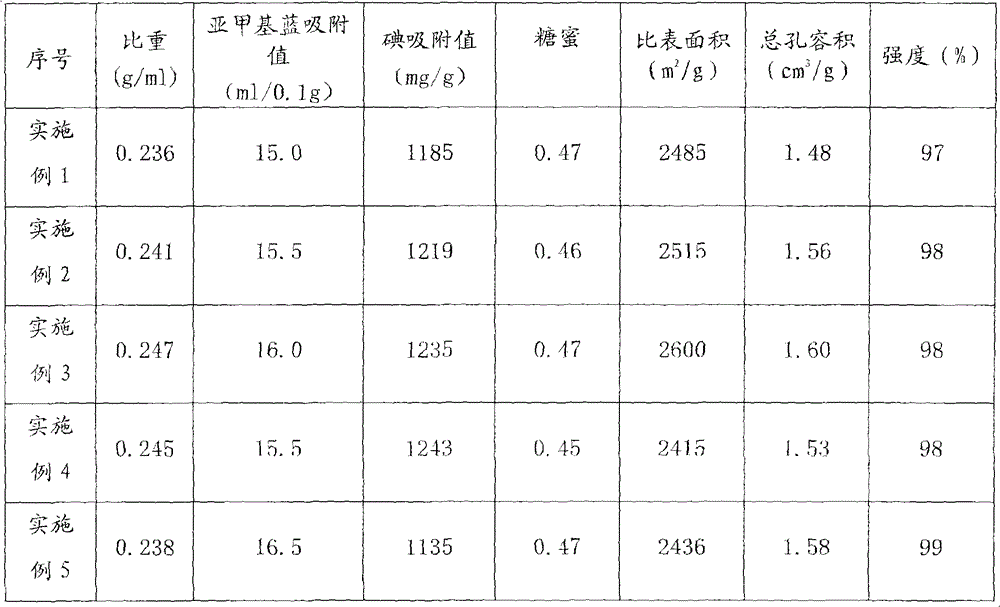Method of preparing sawdust as raw material into particular active carbons
A technology of granular activated carbon and sawdust, applied in chemical instruments and methods, inorganic chemistry, non-metallic elements, etc., can solve the problems of low specific surface area and total pore volume of granular activated carbon, large energy consumption, long process cycle, etc. Appearance, improved specific surface area, and shortened process time
- Summary
- Abstract
- Description
- Claims
- Application Information
AI Technical Summary
Problems solved by technology
Method used
Image
Examples
Embodiment 1
[0028] Dry the sawdust and pulverize it with a pulverizer, use a vibrating sieve to remove the coarse and fine sawdust (screen mesh number 12-40 mesh), and then mix the sawdust and phosphoric acid solution (concentration 55%) and Na2HPO4 with 3% phosphoric acid solution quality Stir evenly, the ratio of phosphorus to wood used is 1.5:1, place it in a heating barrel and heat it to 30°C with steam, stop heating, impregnate at low temperature and keep it warm for 1 hour. After the heat preservation is over, release the sawdust in the barrel and send it to the rotary furnace for plasticization. The plasticization temperature is controlled at 90°C and the plasticization time is about 1 hour. The plasticized plastic material is sent to the kneader for 40 minutes, and then The extruder is extruded into a columnar shape of about 4mm, and then the columnar material is transferred to a fixed dryer for 0.5 hours. The drying temperature is controlled at 150°C. Constant temperature activat...
Embodiment 2
[0030] Dry the sawdust and pulverize it with a pulverizer, and use a vibrating sieve to remove the coarse and fine sawdust (mesh 12-40 mesh), and then mix the sawdust with phosphoric acid solution (concentration 55%) and phosphoric acid solution with 3% Na 2 Stir the HPO4 evenly, the ratio of phosphorus to wood used is 1.5:1, place it in a heating barrel and heat it to 45°C with steam, stop heating, and keep it warm for 2 hours. After the heat preservation is over, release the wood chips in the barrel and send them to the rotary furnace for plasticization. The plasticization temperature is controlled at 100°C, and the plasticization time is about 1 hour. The extrusion machine is extruded into a columnar shape of about 4mm, and the columnar material is transferred to a ball forming machine to form a ball, and then the spherical material is transferred to a fixed dryer for drying for 30 minutes. The drying temperature is controlled at 160 ° C, and the dried material is transferre...
Embodiment 3
[0032] Dry the sawdust and pulverize it with a pulverizer, and use a vibrating sieve to remove the coarse and fine sawdust (mesh 12-40 mesh), and then mix the sawdust with phosphoric acid solution (concentration 55%) and phosphoric acid solution with 3% Na 2 Stir the HPO4 evenly, the ratio of phosphorus to wood used is 1.5:1, place it in a heating barrel and heat it to 60°C with steam, stop heating, and keep it warm for 2.5 hours. After the heat preservation is over, release the sawdust in the barrel and send it to the rotary furnace for plasticization. The plasticization temperature is controlled at 120°C, and the plasticization time is about 1 hour. The plasticized material is sent to the kneader for 40 minutes, and then used The extruder is extruded into a columnar shape of about 4mm, and the columnar material is transferred to a ball forming machine to form a ball, and then the spherical material is transferred to a fixed dryer for drying for 2 hours. The drying temperature...
PUM
 Login to View More
Login to View More Abstract
Description
Claims
Application Information
 Login to View More
Login to View More - R&D
- Intellectual Property
- Life Sciences
- Materials
- Tech Scout
- Unparalleled Data Quality
- Higher Quality Content
- 60% Fewer Hallucinations
Browse by: Latest US Patents, China's latest patents, Technical Efficacy Thesaurus, Application Domain, Technology Topic, Popular Technical Reports.
© 2025 PatSnap. All rights reserved.Legal|Privacy policy|Modern Slavery Act Transparency Statement|Sitemap|About US| Contact US: help@patsnap.com

